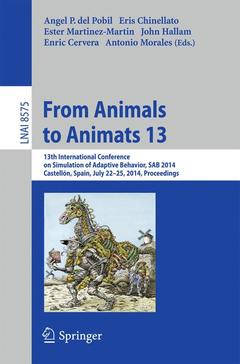Description
From Animals to Animats 13, 2014
13th International Conference on Simulation of Adaptive Behavior, SAB 2014, Castellón, Spain, July 22-25, 2014, Proceedings
Lecture Notes in Artificial Intelligence Series
Coordinators: del Pobil Angel P., Chinellato Eris, Martínez-Martín Ester, Hallam John, Cervera Enric, Morales Antonio
Language: English
Publication date: 08-2014
340 p. · 15.5x23.5 cm · Paperback
340 p. · 15.5x23.5 cm · Paperback
Description
/li>Contents
/li>
This book constitutes the proceedings of the 13th International Conference on Simulation of Adaptive Behavior, SAB 2014, held in Castellón, Spain, in July 2014. The 32 papers presented in this volume were carefully reviewed and selected for inclusion in the proceedings. They cover the main areas in animat research, including the animat approach and methodology, perception and motor control, navigation and internal world models, learning and adaptation, evolution and collective and social behavior.
Animat Approach and Methodology.- A Role for Sleep in Artificial Cognition through Deferred Restructuring of Experience in Autonomous Machines.- Time in Consciousness, Memory and Human-Robot Interaction.- Non-representational Sensorimotor Knowledge.- Perception and Motor Control.- Self-exploration of the Stumpy Robot with Predictive Information Maximization.- Detecting the Vibration in the Artificial Web Inspired by the Spider.- Modelling Reaction Times in Non-linear Classification Tasks.- Multiple Decoupled CPGs with Local Sensory Feedback for Adaptive Locomotion Behaviors of Bio-inspired Walking Robots.- Poramate Manoonpong.- The Role of a Cerebellum-Driven Perceptual Prediction within a Robotic Postural Task.- Biomimetic Agent Based Modelling Using Male Frog Calling Behaviour as a Case Study.- Navigation and Internal World Models Snapshot Homing Navigation Based on Edge Features.- Ground-Nesting Insects Could Use Visual Tracking for Monitoring Nest Position during Learning Flights.- Adaptive Landmark-Based Navigation System Using Learning Techniques.- Robustness Study of a Multimodal Compass Inspired from HD-Cells and Dynamic Neural Fields.- Learning and Adaptation.- Developmental Dynamics of RNNPB: New Insight about Infant Action Development.- Simulating the Emergence of Early Physical and Social Interactions: A Developmental Route through Low Level Visuomotor Learning.- Intrinsically Motivated Decision Making for Situated, Goal-Driven Agents.- An Anti-hebbian Learning Rule to Represent Drive Motivations for Reinforcement Learning.- Unsupervised Learning of Sensory Primitives from Optical Flow Fields.- Reinforcement-Driven Shaping of Sequence Learning in Neural Dynamics.- Rapid Humanoid Motion Learning through Coordinated, Parallel Evolution.- Evolution.- Programmable Self-assembly with Chained Soft Cells: An Algorithm to Fold into 2-D Shapes.- Voxel Robot: A Pneumatic Robot with Deformable Morphology.- Task-Driven Evolution of Modular Self-reconfigurable Robots.- A Bacterial-Based Algorithm to Simulate Complex Adaptive Systems.- Online Evolution of Deep Convolutional Network for Vision-Based Reinforcement Learning.- Collective and Social Behavior.- A Swarm Robotics Approach to Task Allocation under Soft Deadlines and Negligible Switching Costs.- Supervised Robot Groups with Reconfigurable Formation: Theory and Simulations.- Coupling Learning Capability and Local Rules for the Improvement of the Objects’ Aggregation Task by a Cognitive Multi-Robot System.- Honeybee-Inspired Quality Monitoring of Routing Paths in Mobile Ad Hoc Networks.- Human Inspiration and Comparison for Monitoring Strategies in a Robotic Convoy Task.- Animal Social Behaviour: A Visual Analysis.- Crowd Emotion Detection Using Dynamic Probabilistic Models.
© 2024 LAVOISIER S.A.S.




